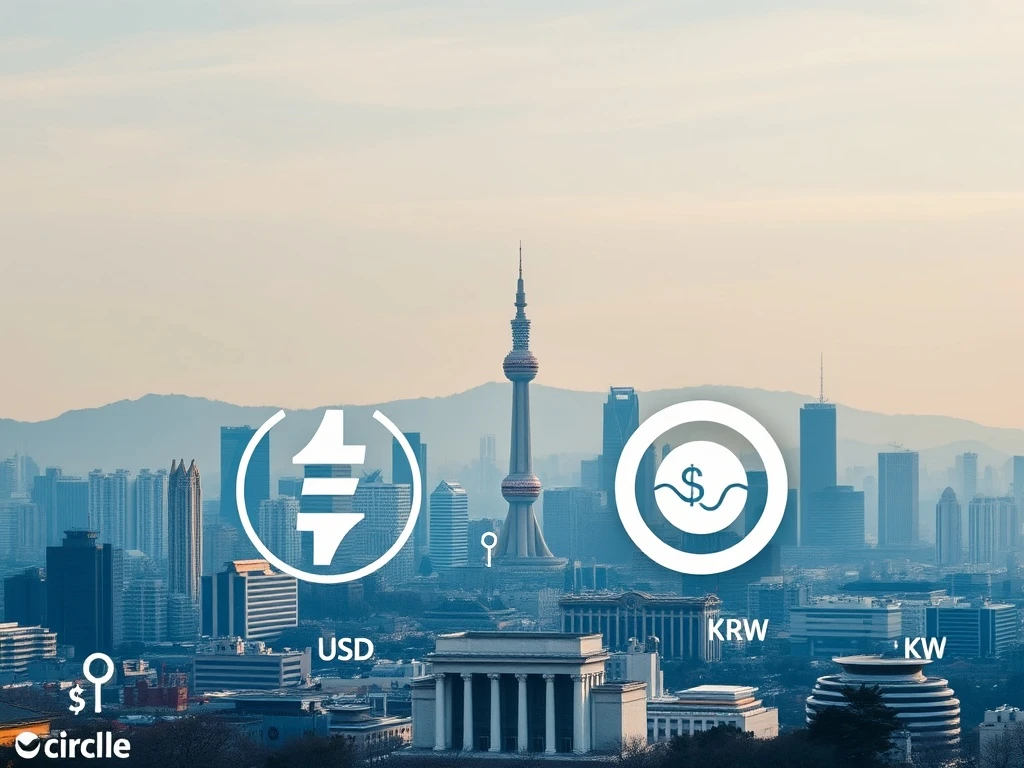Tether Circle South Korea: Crucial Meetings Poised to Boost Stablecoin Adoption

A pivotal moment is unfolding in the cryptocurrency world, particularly for the burgeoning stablecoin market. Leading stablecoin issuers, Tether and Circle, are reportedly holding significant meetings with top executives from South Korea’s largest banks. These discussions signal a potential shift in how traditional financial institutions engage with digital assets. Investors and enthusiasts keenly watch these developments, as they could reshape the financial landscape and accelerate **global stablecoin adoption**.
Tether Circle South Korea: Crucial Banking Engagements
Reports from local media indicate that Tether and Circle are set to meet with the CEOs of South Korea’s four largest banks this week. These high-level discussions involve the “Big Four” banking groups, officially recognized as domestic systemically important banks by the Financial Services Commission. Specifically, Shinhan Financial Group CEO Jin Ok-dong and Hana Financial Group CEO Ham Young-joo have scheduled meetings with Circle President Heath Tarbert on Friday. Additionally, Young-joo will reportedly meet a Tether official on the same day. KB Financial Group’s chief digital and information technology officer Lee Chang-kwon and Woori Bank President Jeong Jin-wan also plan to meet Circle’s Tarbert at an undisclosed time.
The primary objectives of these meetings are multifaceted. Participants expect to discuss potential partnerships and the issuance of Korean won-backed stablecoins. Furthermore, they will explore the distribution of US dollar-backed stablecoins within South Korea. This strategic engagement highlights a growing interest from traditional finance in leveraging stablecoin technology. It also underscores the importance of a regulated framework for digital currencies.
South Korea Stablecoin: Evolving Regulatory Frameworks
These meetings occur amidst significant developments in South Korea’s regulatory approach to digital assets. Earlier reports indicated that South Korea is actively preparing to introduce a comprehensive regulatory framework specifically for won-backed stablecoins. This upcoming bill will reportedly form part of the second phase of the nation’s Virtual Asset User Protection Act. The government aims to provide clear guidelines for the burgeoning stablecoin market, ensuring both innovation and consumer protection.
Moreover, the nation’s financial sector has shown increasing interest in stablecoins. In early July, shares of several major South Korean banks surged following trademark filings for stablecoins. This was followed by statements from Kakao Corporation’s banking arm, KakaoBank, announcing its active participation plans in the stablecoin market. Significantly, the Bank of Korea recently suspended its central bank digital currency (CBDC) tests. Instead, it chose to prioritize supporting won-backed stablecoins, marking a clear pivot in national digital currency strategy. Prior to this, eight major South Korean banks were planning a collaborative effort to launch a local fiat-pegged stablecoin by next year. This collective interest demonstrates a robust domestic push for **South Korea stablecoin** initiatives.
Advancing Stablecoin Regulation and Global Adoption
The meetings between **Tether Circle South Korea** bank executives are not isolated incidents. They represent a continuation of high-level engagements by these stablecoin giants as global regulators move towards clearer rules for digital assets. In early March, Tether CEO Paolo Ardoino and Circle’s Tarbert attended a Commodities Futures Trading Commission (CFTC) CEO forum in Washington, D.C. This event saw participation from numerous crypto executives and White House representatives. Following this, mid-February reports suggested Tether was actively consulting with US congressional lawmakers to help craft stablecoin regulatory policies. The US Treasury Department recently requested public comments related to the passage of the Guiding and Establishing National Innovation for US Stablecoins (GENIUS) Act, further indicating a push for clear **stablecoin regulation**.
Beyond regulatory discussions, Tether has also forged agreements with governments in other countries. For instance, it signed deals with Guinea and Uzbekistan to explore blockchain and peer-to-peer payment adoption. In January, the company announced plans to relocate operations to El Salvador after multiple meetings between Ardoino and President Nayib Bukele. These actions highlight a strategic global outreach by stablecoin issuers, aiming to integrate digital currencies into diverse financial ecosystems. The consistent efforts by these firms, coupled with increasing interest from **Korean banks crypto** initiatives, suggest a future where stablecoins play a much larger role in international finance.
The Future of Stablecoins and Banking Partnerships
The ongoing dialogues between Tether, Circle, and South Korean banks underscore a growing recognition of stablecoins’ potential within traditional financial systems. These discussions could pave the way for innovative partnerships, leading to more efficient cross-border payments and new financial products. As South Korea actively shapes its **stablecoin regulation**, it sets a precedent for other nations contemplating similar frameworks. The commitment of major stablecoin issuers to engage with regulators and financial institutions globally is a clear sign of the maturing digital asset industry. Ultimately, these collaborative efforts are crucial for fostering trust, ensuring stability, and driving the widespread **global stablecoin adoption** that many foresee.









